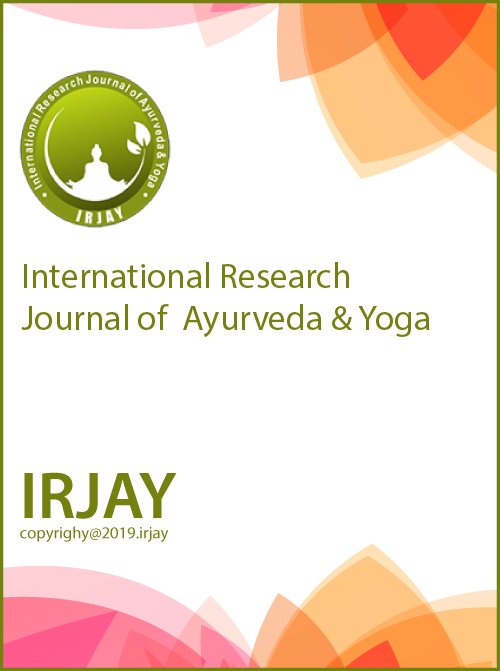A Literature Review on Water Purification Methods in Ayurveda: Insights from the Brihattrayee Texts
DOI:
https://doi.org/10.48165/IRJAY.2025.80310Keywords:
Ashtanga Hridaya, Ashtanga Sangraha, Ayurveda, Charaka Samhita, Jalanirvishikarana, Sushruta Samhita, Traditional Medicine, Water Contamination, Water PurificationAbstract
Water is a vital component for the sustenance of all living organisms. Ayurveda, the ancient Indian system of medicine, emphasizes the significance of safe drinking water, its purification, and its role in maintaining health. The Brihattrayee texts, namely Charaka Samhita, Sushruta Samhita, Ashtanga Hridaya, and Ashtanga Sangraha, offer detailed descriptions of water, its properties, sources, and purification methods. This literature review aims to critically analyze the water purification methods described in the Brihattrayee texts, focusing on their scientific relevance and application in modern water purification techniques. A comprehensive review was conducted of the four core Ayurvedic texts – Charaka Samhita, Sushruta Samhita, Ashtanga Hridaya, and Ashtanga Sangraha – studied at the Central Library of Shri B.M. Kankanawadi Ayurveda Mahavidyalaya, Belagavi, Karnataka. The methods of water purification outlined in these texts were examined and compared with contemporary scientific approaches. The review reveals that various Ayurvedic purification techniques, such as boiling, filtration, exposure to sunlight, and the use of herbal and mineral substances such as kataka, gomeda, and pearls, align with modern scientific methods of water treatment. The texts also emphasize the importance of water’s quality based on its source, season, and contamination level, highlighting the use of plant-based coagulants and natural filtration methods. The Ayurvedic methods of water purification offer sustainable and eco-friendly alternatives to modern practices, especially in resource-limited settings. The integration of these traditional techniques with modern water purification systems could potentially improve access to safe drinking water while maintaining environmental sustainability. Further scientific exploration into these methods can lead to the development of cost-effective solutions for global water quality issues.
Downloads
References
Sreekumar T. Ashtanga hridaya sutrasthana. 2nd ed., Vol. 1., Ch. 5. Shloka 22. New Delhi: Chaukhambha Publications; 2013. p. 123. 2. Srikantha Murthy KR. Ashtanga sangraha sutrasthana. 9th ed., Vol. 1. 2005., Ch. 6. Shlokas 29-30. New Delhi: Chaukhambha Publications; 2010. p. 87.
Shashirekha HK, Bargale SS. Charaka samhita sutrasthana. Vol. 1. Reprint ed. Ch. 27. Chaukhambha Publications; 2022. p. 521. 4. Patil VC, Rajeshwari NM. Sushruta samhita sutrasthana. 1st ed., Vol. 1. Varanasi: Chaukhamba Vishvabharati; 2018. p. 451. 5. Patil VC, Rajeshwari NM. Sushruta samhita kalpasthana. 1st ed., Vol. 3. Varanasi: Chaukhamba Vishvabharati; 2018. p. 20. 6. Sreekumar T. Ashtanga hridaya sutrasthana. 2nd ed., Vol. 1. Shloka 6-7. Varanasi: Choukumba Surbharati Prakashna; 2013. p. 118. 7. Srikantha Murthy KR. Ashtanga sangraha sutrasthana. 9th ed., Vol. 1. New Delhi: Chaukhambha Publications; 2005. p. 180-1.
Shahirekha HK, Sukumar BS. Charaka samhita sutrasthana. Vol. 1. Ch. 27. Reprint ed. New Delhi: Chaukhambha Publications; 2022. 9. Patil VC, Rajeshwari NM. Sushruta samhita sutrasthana. 1st ed., Vol. 1. Ch. 45. New Delhi: Chaukhambha Publications; 2018. 10. Patil VC, Rajeshwari NM. Sushruta samhita sutrasthana. 1st ed., Vol. 1. Shloka 17, Ch. 45. New Delhi: Chaukhambha Publications; 2018. p. 456.
Patil VC, Rajeshwari NM. Sushruta samhita sutrasthana. 1st ed., Vol. 1., Shloka 18. New Delhi: Chaukhambha Publications; 2018. p. 456. 12. Patil VC, Rajeshwari NM. Sushruta samhita sutrasthana. 1st ed.,
Vol. 1. Shloka 12. New Delhi: Chaukhambha Publications; 2018. p. 457.
Patil VC, Rajeshwari NM. Sushruta samhita kalpasthana. 1st ed., Vol. 3. Shloka 9. New Delhi: Chaukhambha Publications; 2018. p. 20.
Sreekumar T. Ashtanga hridaya sutrasthana. 2nd ed., Vol. 1. Shloka 1-2. New Delhi: Chaukhambha Publications; 2018. p. 117. 15. Srikantha Murthy KR. Ashtanga sangraha sutrasthana. 9th ed., Vol. 1. New Delhi: Chaukhambha Publications; 2005. p. 81.
Srikantha Murthy KR. Ashtanga sangraha sutrasthana. 9th ed., Vol. 1. Shloka 25-26. New Delhi: Chaukhambha Publications; 2005. p. 86. 17. Srikantha Murthy KR. Ashtanga sangraha sutrasthana. 9th ed., Vol. 1. Shloka 41-47. New Delhi: Chaukhambha Publications; 2005. p. 181.


